Effects of Albedo and Thermal Inertia on Pavement Surface Temperatures with Convective Boundary Conditions—A CFD Study
Abstract
:1. Introduction
2. Materials and Methods
3. Results and Discussions
3.1. Model Validation
3.2. Surface Temperatures with Varying Albedo Values
3.3. Surface Temperatures with Varying Thermal Inertia Values
4. Conclusions
Author Contributions
Funding
Institutional Review Board Statement
Informed Consent Statement
Data Availability Statement
Acknowledgments
Conflicts of Interest
References
- Howard, L. The Climate of London: Deduced from Meteorological Observations Made in the Metropolis and at Various Places Around It; Harvey and Darton: London, UK, 1833; Volume 1. [Google Scholar]
- Mavrogianni, A.; Davies, M.; Batty, M.; Belcher, S.E.; Bohnenstengel, S.I.; Carruthers, D.; Chalabi, Z.; Croxford, B.; Demanuele, C.; Evans, S.; et al. The comfort, energy and health implications of London’s urban heat island. Build. Serv. Eng. Res. Technol. 2011, 32, 35–52. [Google Scholar] [CrossRef]
- Ren, Z.; Wang, X.; Chen, D.; Wang, C.; Thatcher, M. Constructing weather data for building simulation considering urban heat island. Build. Serv. Eng. Res. Technol. 2014, 35, 69–82. [Google Scholar] [CrossRef]
- Levermore, G.J.; Parkinson, J.B.; Laycock, P.J.; Lindley, S. The urban heat island in Manchester 1996–2011. Build. Serv. Eng. Res. Technol. 2015, 36, 343–356. [Google Scholar] [CrossRef]
- Madlener, R.; Sunak, Y. Impacts of urbanization on urban structures and energy demand: What can we learn for urban energy planning and urbanization management? Sustain. Cities Soc. 2011, 1, 45–53. [Google Scholar] [CrossRef]
- Bornstein, R.D. Observations of the urban heat island effect in New York City. J. Appl. Meteorol. 1968, 7, 575–582. [Google Scholar] [CrossRef]
- Oke, T.R. The energetic basis of the urban heat island. Q. J. R. Meteorol. Soc. 1982, 108, 1–24. [Google Scholar] [CrossRef]
- Grimmond, S. Urbanization and global environmental change: Local effects of urban warming. Geogr. J. 2007, 173, 83–88. [Google Scholar] [CrossRef]
- Ichinose, T.; Futoshi, M.; Kumi, K. Counteracting urban heat islands in Japan. In Urban Energy Transition; Elsevier: Amsterdam, The Netherlands, 2008; pp. 365–380. [Google Scholar]
- Synnefa, A.; Karlessi, T.; Gaitani, N.; Santamouris, M.; Assimakopoulos, D.N.; Papakatsikas, C. Experimental testing of cool colored thin layer asphalt and estimation of its potential to improve the urban microclimate. Build. Environ. 2011, 46, 38–44. [Google Scholar] [CrossRef]
- Chen, J.; Wang, H.; Li, M.; Li, L. Evaluation of pavement responses and performance with thermal modified asphalt mixture. Mater. Des. 2016, 111, 88–97. [Google Scholar] [CrossRef]
- Wolfe, M.I.; Kaiser, R.; Naughton, M.P.; Mirabelli, M.C.; Yoon, S.S.; Hanzlick, R.; Henderson, A.K. Heat-related mortality in selected United States cities, summer 1999. Am. J. Forensic Med. Pathol. 2001, 22, 352–357. [Google Scholar] [CrossRef]
- Santamouris, M. Using cool pavements as a mitigation strategy to fight urban heat island—A review of the actual developments. Renew. Sust. Energy Rev. 2013, 26, 224–240. [Google Scholar] [CrossRef]
- Satterthwaite, D. Cities’ contribution to global warming: Notes on the allocation of greenhouse gas emissions. Environ. Urban. 2008, 20, 539–549. [Google Scholar] [CrossRef] [Green Version]
- Gorsevski, V.; Taha, H.; Quattrochi, D.; Luvall, J. Air pollution prevention through urban heat island mitigation: An update on the Urban Heat Island Pilot Project. Proc. ACEEE Summer Study 1998, 9, 23–32. [Google Scholar]
- Kolokotroni, M. Night ventilation cooling of office buildings: Parametric analyses of conceptual energy impacts/Discussion. Ashrae Trans. 2001, 107, 479. [Google Scholar]
- Stone, B.; Hess, J.J.; Frumkin, H. Urban form and extreme heat events: Are sprawling cities more vulnerable to climate change than compact cities? Environ. Health Perspect. 2010, 118, 1425–1428. [Google Scholar] [CrossRef] [PubMed] [Green Version]
- Akbari, H.; Rose, L.S. Urban surfaces and heat island mitigation potentials. J. Hum. Environ. Stud. 2008, 11, 85–101. [Google Scholar] [CrossRef] [Green Version]
- Asaeda, T.; Ca, V.T.; Wake, A. Heat storage of pavement and its effect on the lower atmosphere. Atmos. Environ. 1996, 30, 413–427. [Google Scholar] [CrossRef]
- Takebayashi, H.; Moriyama, M. Study on surface heat budget of various pavements for urban heat island mitigation. Adv. Mater. Sci. Eng. 2012, 2012, 523051. [Google Scholar] [CrossRef] [Green Version]
- Li, H.; Harvey, J.; Kendall, A. Field measurement of albedo for different land cover materials and effects on thermal performance. Build. Environ. 2013, 59, 536–546. [Google Scholar] [CrossRef]
- Morovatdar, A.; Ashtiani, R.S.; Licon, C.; Tirado, C.; Mahmoud, E. Novel framework for the quantification of pavement damages in the overload corridors. Transp. Res. Rec. 2020, 2674, 179–191. [Google Scholar] [CrossRef]
- Wen, C.D.; Mudawar, I. Modeling the effects of surface roughness on the emissivity of aluminum alloys. Int. J. Heat Mass Transf. 2006, 49, 4279–4289. [Google Scholar] [CrossRef]
- Wen, C.D.; Mudawar, I. Emissivity characteristics of polished aluminum alloy surfaces and assessment of multispectral radiation thermometry (MRT) emissivity models. Int. J. Heat Mass Transf. 2005, 48, 1316–1329. [Google Scholar] [CrossRef]
- Wen, C.D.; Mudawar, I. Emissivity characteristics of roughened aluminum alloy surfaces and assessment of multispectral radiation thermometry (MRT) emissivity models. Int. J. Heat Mass Transf. 2004, 47, 3591–3605. [Google Scholar] [CrossRef]
- Wieczorowski, M.; Rozanski, L. Roughness aspects in thermal analysis of machine tools. In Proceedings of the XVIII IMEKO World Congress Metrology for a Sustainable Development, Rio de Janeiro, Brazil, 17–22 September 2006; Volume 2, p. 1701. [Google Scholar]
- Qin, Y. Urban canyon albedo and its implication on the use of reflective cool pavements. Energy Build. 2015, 96, 86–94. [Google Scholar] [CrossRef]
- Yaghoobian, N.; Kleissl, J. Effect of reflective pavements on building energy use. Urban Clim. 2012, 2, 25–42. [Google Scholar] [CrossRef] [Green Version]
- Akbari, H.; Pomerantz, M.; Taha, H. Cool surfaces and shade trees to reduce energy use and improve air quality in urban areas. Sol. Energy 2001, 70, 295–310. [Google Scholar] [CrossRef]
- Richard, C.; Dore, G.; Lemieux, C.; Bilodeau, J.P.; Haure-Touze, J. Albedo of pavement surfacing materials: In situ measurements. In Proceedings of the 16th International Conference on Cold Regions Engineering, Salt Lake City, UT, USA, 19–22 July 2015; pp. 181–192. [Google Scholar]
- Berdahl, P.; Bretz, S.E. Preliminary survey of the solar reflectance of cool roofing materials. Energy Build. 1997, 25, 149–158. [Google Scholar] [CrossRef] [Green Version]
- Doulos, L.; Santamouris, M.; Livada, I. Passive cooling of outdoor urban spaces. The role of materials. Sol. Energy 2004, 77, 231–249. [Google Scholar]
- Bobes-Jesus, V.; Pascual-Muñoz, P.; Castro-Fresno, D.; Rodriguez-Hernandez, J. Asphalt solar collectors: A literature review. Appl. Energy 2013, 102, 962–970. [Google Scholar] [CrossRef]
- Higashiyama, H.; Sano, M.; Nakanishi, F.; Takahashi, O.; Tsukuma, S. Field measurements of road surface temperature of several asphalt pavements with temperature rise reducing function. Case Stud. Constr. Mater. 2016, 4, 73–80. [Google Scholar] [CrossRef] [Green Version]
- Wan, W.C.; Hien, W.N.; Ping, T.P.; Aloysius, A.Z.W. A study on the effectiveness of heat mitigating pavement coatings in Singapore. J. Heat Island Inst. Int. 2012, 7, 238–247. [Google Scholar]
- Sarat, A.A.; Eusuf, M.A. An experimental study on observed heating characteristics of urban pavement. J. Surv. Constr. Prop. 2012, 3, 1–12. [Google Scholar] [CrossRef] [Green Version]
- Johnsson, J.; Adl-Zarrabi, B. A numerical and experimental study of a pavement solar collector for the northern hemisphere. Appl. Energy 2020, 260, 114286. [Google Scholar] [CrossRef]
- Masoumi, A.P.; Tajalli-Ardekani, E.; Golneshan, A.A. Investigation on performance of an asphalt solar collector: CFD analysis, experimental validation and neural network modeling. Sol. Energy 2020, 207, 703–719. [Google Scholar] [CrossRef]
- Swanson, M.; Hobbs, A. Urban heat island effect: Comparing thermal and radiation effects of asphalt and concrete pavements on adjacent buildings using CFD methods. Contact Urticaria Syndr. 2014, 33, 1–9. [Google Scholar]
- Blocken, B.; Stathopoulos, T.; Saathoff, P.; Wang, X. Numerical evaluation of pollutant dispersion in the built environment: Comparisons between models and experiments. J. Wind Eng. Ind. Aerodyn. 2008, 96, 1817–1831. [Google Scholar] [CrossRef] [Green Version]
- Gousseau, P.; Blocken, B.; Stathopoulos, T.; Van Heijst, G.J.F. CFD simulation of near-field pollutant dispersion on a high-resolution grid: A case study by LES and RANS for a building group in downtown Montreal. Atmos. Environ. 2011, 45, 428–438. [Google Scholar] [CrossRef] [Green Version]
- Tominaga, Y.; Stathopoulos, T. CFD simulation of near-field pollutant dispersion in the urban environment: A review of current modeling techniques. Atmos. Environ. 2013, 79, 716–730. [Google Scholar] [CrossRef] [Green Version]
- Di Sabatino, S.; Buccolieri, R.; Salizzoni, P. Recent advancements in numerical modelling of flow and dispersion in urban areas: A short review. Int. J. Environ. Pollut. 2013, 52, 172–191. [Google Scholar] [CrossRef]
- Kato, S.; Murakami, S.; Mochida, A.; Akabayashi, S.; Tominaga, Y. Velocity-pressure field of cross ventilation with open windows analyzed by wind tunnel and numerical simulation. J. Wind Eng. Ind. Aerodyn. 1992, 44, 2575–2586. [Google Scholar] [CrossRef]
- Ramponi, R.; Blocken, B. CFD simulation of cross-ventilation for a generic isolated building: Impact of computational parameters. Build. Environ. 2012, 53, 34–48. [Google Scholar] [CrossRef]
- Mochida, A.; Lun, I.Y.F. Prediction of wind environment and thermal comfort at pedestrian level in urban area. J. Wind Eng. Ind. Aerodyn. 2008, 96, 1498–1527. [Google Scholar] [CrossRef]
- Murakami, S.; Ooka, R.; Mochida, A.; Yoshida, S. CFD analysis of wind climate from human scale to urban scale. J. Wind Eng. Ind. Aerodyn. 1999, 81, 57–81. [Google Scholar] [CrossRef]
- Stathopoulos, T. Pedestrian level winds and outdoor human comfort. J. Wind Eng. Ind. Aerodyn. 2006, 94, 769–780. [Google Scholar] [CrossRef]
- Yoshie, R.; Mochida, A.; Tominaga, Y.; Kataoka, H.; Harimoto, K.; Nozu, T.; Shirasawa, T. Cooperative project for CFD prediction of pedestrian wind environment in the Architectural Institute of Japan. J. Wind Eng. Ind. Aerodyn. 2007, 95, 1551–1578. [Google Scholar] [CrossRef]
- Nasir, D.S.; Hughes, B.R.; Calautit, J.K. A CFD analysis of several design parameters of a road pavement solar collector (RPSC) for urban application. Appl. Energy. 2017, 186, 436–449. [Google Scholar] [CrossRef]
- Takahashi, K.; Yoshida, H.; Tanaka, Y.; Aotake, N.; Wang, F. Measurement of thermal environment in Kyoto city and its prediction by CFD simulation. Energy Build. 2004, 36, 771–779. [Google Scholar] [CrossRef]
- Nazarian, N.; Kleissl, J. Realistic solar heating in urban areas: Air exchange and street-canyon ventilation. Build. Environ. 2016, 95, 75–93. [Google Scholar] [CrossRef] [Green Version]
- Ng, S.C.; Low, K.S.; Tioh, N.H. Newspaper sandwiched aerated lightweight concrete wall panels—Thermal inertia, transient thermal behavior and surface temperature prediction. Energy Build. 2011, 43, 1636–1645. [Google Scholar] [CrossRef]
- ANSYS Fluent Tutorial Guide Release 18 January 2017. Available online: http://users.abo.fi/rzevenho/ansys%20fluent%2018%20tutorial%20guide.pdf (accessed on 1 June 2020).
- Woldu, Y.; Fritz, A. Using CFD to Analyze Thermal and Optical Influence on a Zero Pressure Balloon at Floating Condition. Master’s Thesis, Lulea University of Technology, Lulea, Sweden, 2018. [Google Scholar]
- Moon, J.H.; Lee, J.W.; Jeong, C.H.; Lee, S.H. Thermal comfort analysis in a passenger compartment considering the solar radiation effect. Int. J. Therm. Sci. 2016, 107, 77–88. [Google Scholar] [CrossRef]
- Ajay, K.; Lal, K. Experimental and CFD investigation on the efficiency of parabolic solar collector involving Al2O3/H2O (DI) nanofluid as a working fluid. Int. J. Renew. Energy Res. 2016, 6, 392–401. [Google Scholar]
- Adeniyi, A.A.; Mohammed, A.; Aladeniyi, K. Analysis of a solar dryer box with ray tracing CFD technique. Int. J. Sci. Res. 2012, 3, 1–5. [Google Scholar]
- Jonsson, J. Including Solar Load in CFD Analysis of Temperature Distribution in a Car Passenger Compartment. Master’s Thesis, Lulea University of Technology, Lulea, Sweden, 2007. [Google Scholar]
- ISO 7730:2005. Ergonomics of the Thermal Environment-Analytical Determination and Interpretation of Thermal Comfort Using Calculation of the PMV and PPD Indices and Local Thermal Comfort Criteria. 2005. Available online: https://www.iso.org/standard/39155.html (accessed on 1 September 2021).
- Launder, B.E.; Spalding, D.B. The Numerical Computation of Turbulent Flows. Comput. Methods Appl. Mech. Eng. 1974, 3, 269–289. [Google Scholar] [CrossRef]
- Yu, B.; Lu, Q. Estimation of albedo effect in pavement life cycle assessment. J. Clean. Prod. 2014, 64, 306–309. [Google Scholar] [CrossRef]
- Kaloush, K.E.; Carlson, J.D.; Golden, J.S.; Phelan, P.E. The Thermal and Radiative Characteristics of Concrete Pavements in Mitigating Urban Heat Island Effects; (No. PCA R&D SN2969); Portland Cement Association: Skokie, IL, USA, 2008. [Google Scholar]
- Jeanjean, A.; Olives, R.; Py, X. Selection criteria of thermal mass materials for low-energy building construction applied to conventional and alternative materials. Energy Build. 2013, 63, 36–48. [Google Scholar] [CrossRef]
- Dehdezi, P.K.; Hall, M.R.; Dawson, A. Thermophysical optimization of specialized concrete pavement materials for collection of surface heat energy and applications for shallow heat storage. Transp. Res. Rec. 2011, 2240, 96–106. [Google Scholar] [CrossRef]
- Qin, Y.; Hiller, J.E. Understanding pavement-surface energy balance and its implications on cool pavement development. Energy Build. 2014, 85, 389–399. [Google Scholar] [CrossRef]



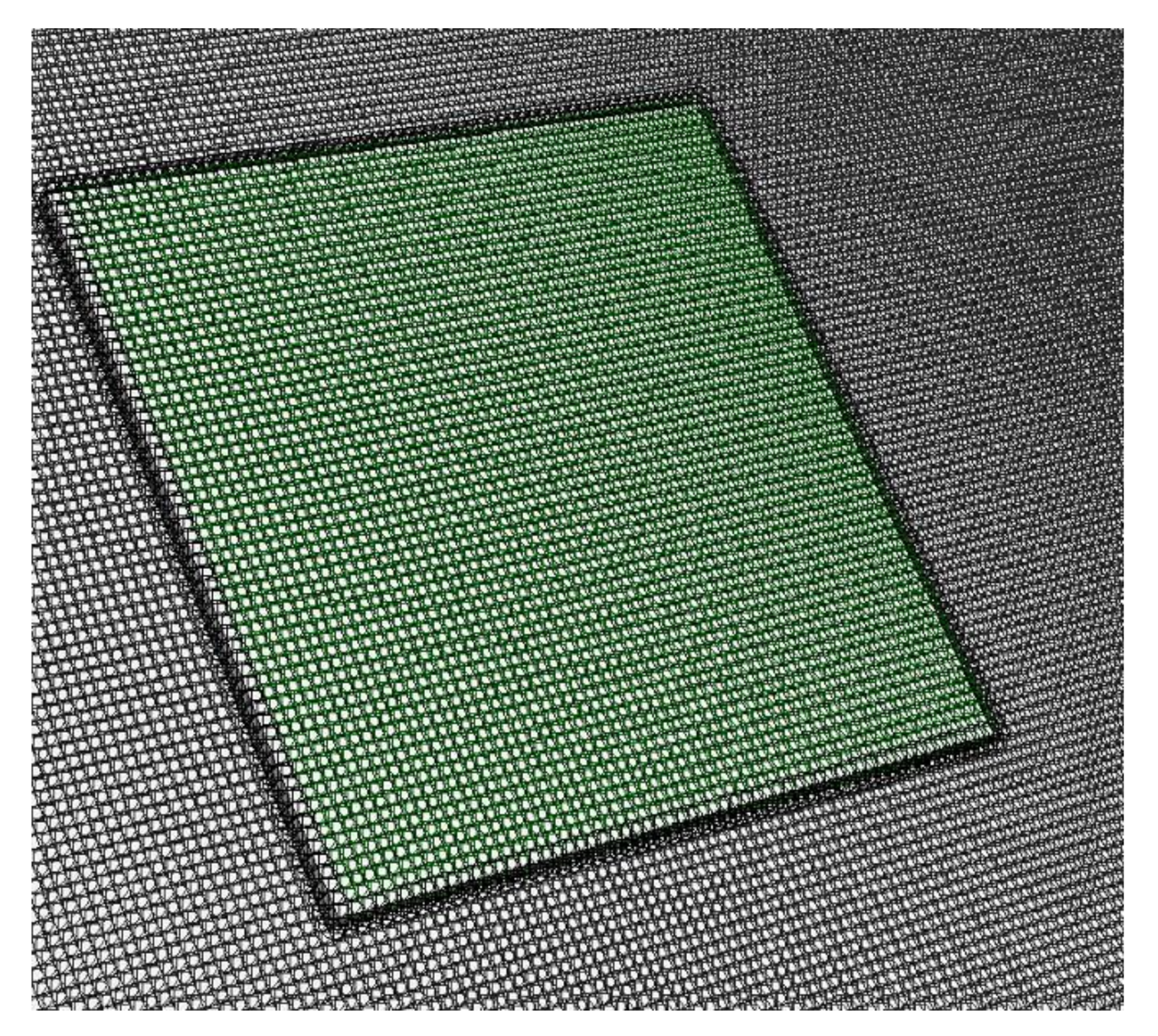

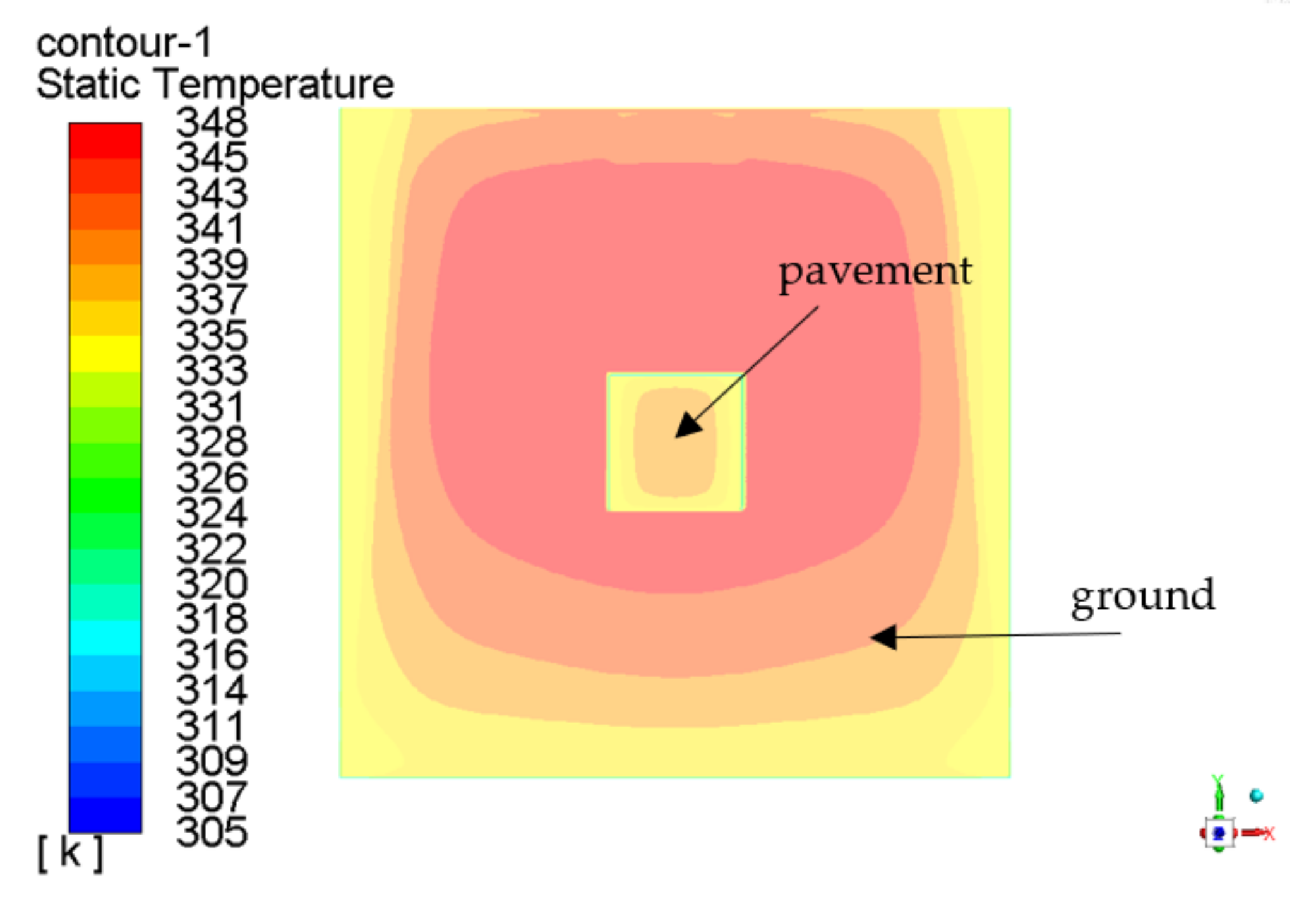
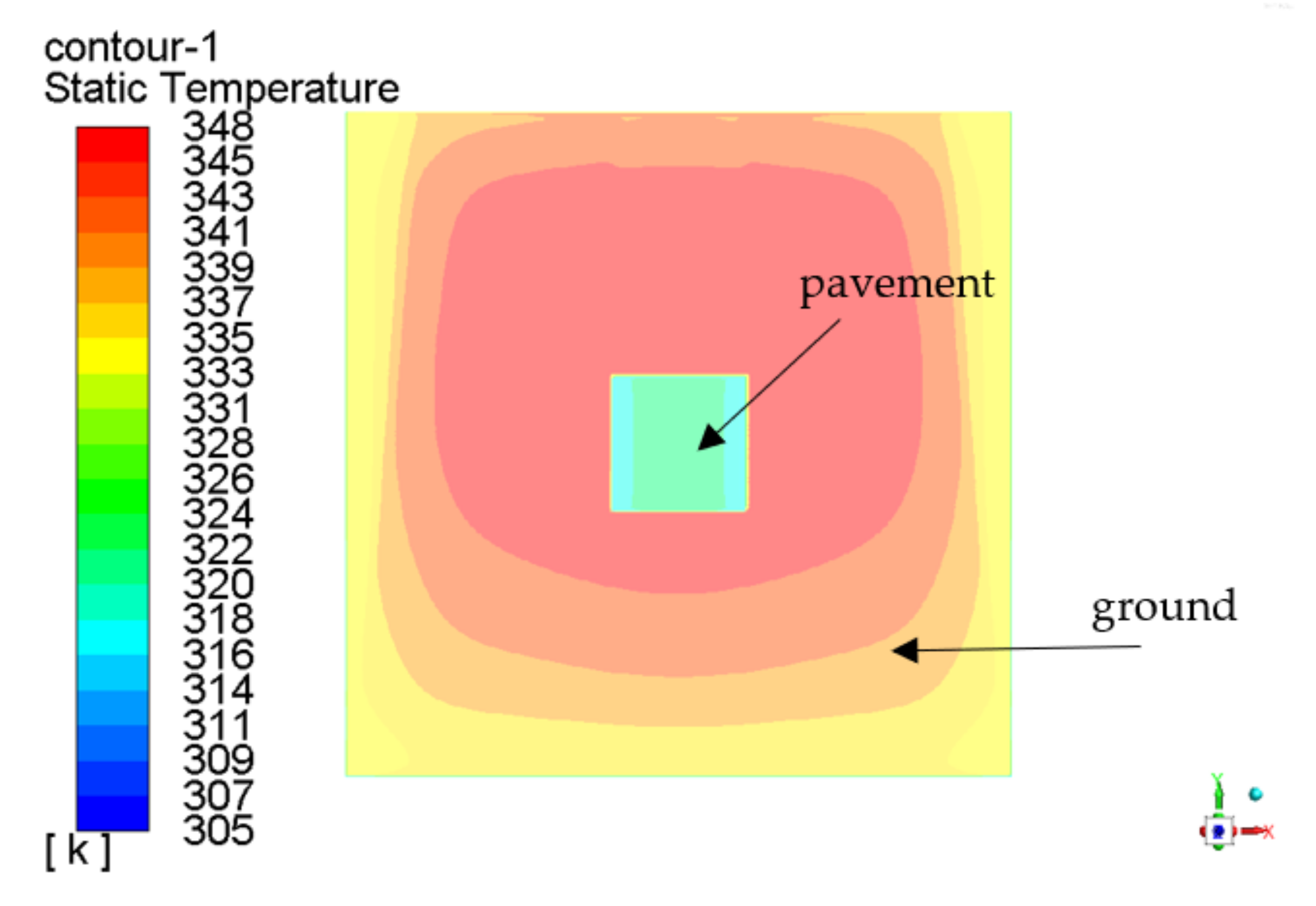
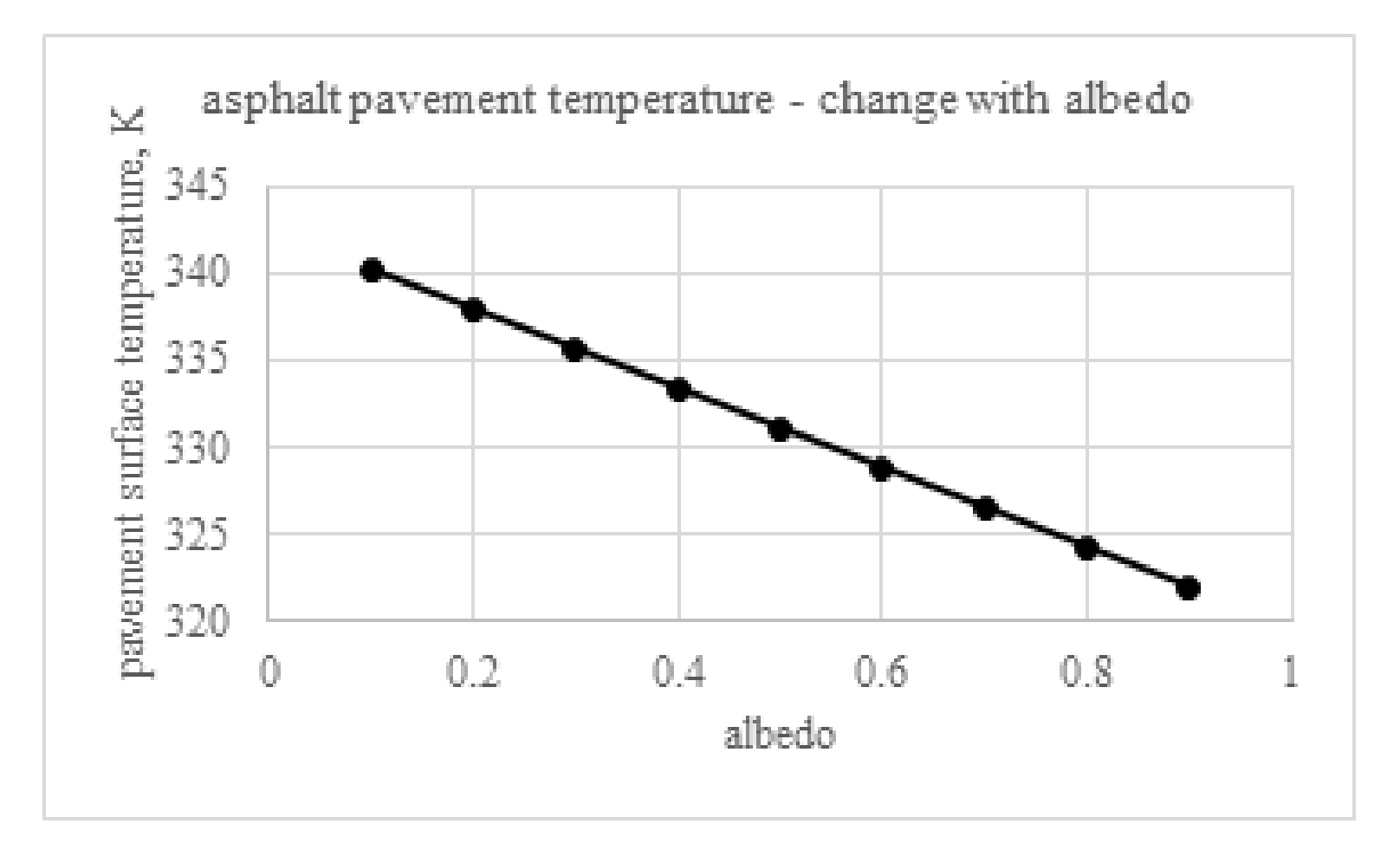
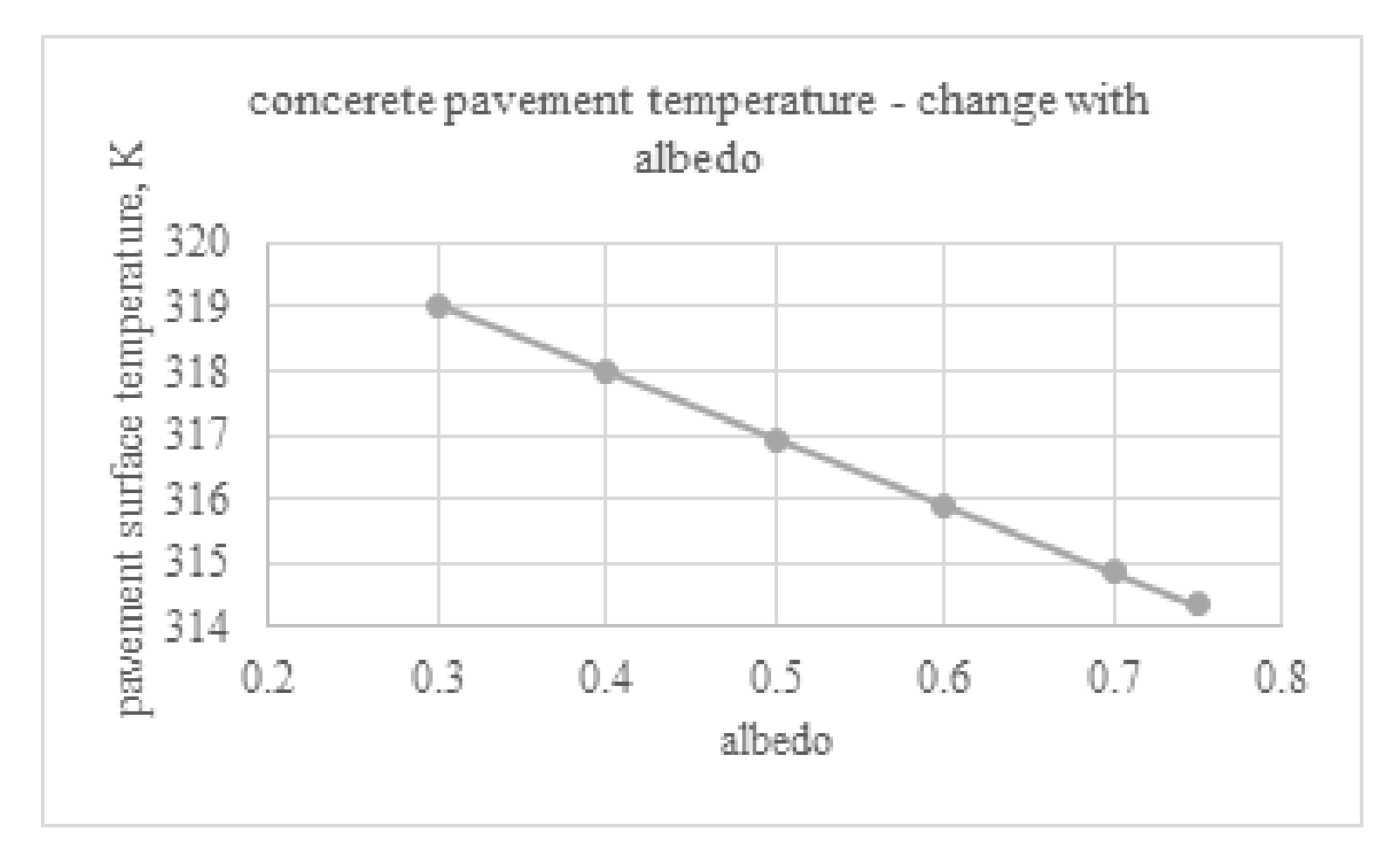


| Property | Asphalt | Concrete | Ground |
|---|---|---|---|
| Density, kg/m3 | 2243 | 1800 | 1200 |
| Specific Heat, J/kg K | 633 | 1150 | 958 |
| Thermal Conductivity, W/m K | 0.74 | 1.69 | 0.04 |
| Emissivity | 0.94 | 0.94 | 0.94 |
| Reflectivity | 0.1 | 0.45 | 0.15 |
| Parameters | Methods |
|---|---|
| Gradient | Least Squares Cell-Based |
| Pressure | Second Order |
| Momentum | Second Order Upwind |
| Turbulent Kinetic Energy | First Order Upwind |
| Turbulent Dissipation Rate | First Order Upwind |
| Energy | Second Order Upwind |
| Discrete Ordinates | First Order Upwind |
Publisher’s Note: MDPI stays neutral with regard to jurisdictional claims in published maps and institutional affiliations. |
© 2021 by the authors. Licensee MDPI, Basel, Switzerland. This article is an open access article distributed under the terms and conditions of the Creative Commons Attribution (CC BY) license (https://creativecommons.org/licenses/by/4.0/).
Share and Cite
Acharya, T.; Riehl, B.; Fuchs, A. Effects of Albedo and Thermal Inertia on Pavement Surface Temperatures with Convective Boundary Conditions—A CFD Study. Processes 2021, 9, 2078. https://doi.org/10.3390/pr9112078
Acharya T, Riehl B, Fuchs A. Effects of Albedo and Thermal Inertia on Pavement Surface Temperatures with Convective Boundary Conditions—A CFD Study. Processes. 2021; 9(11):2078. https://doi.org/10.3390/pr9112078
Chicago/Turabian StyleAcharya, Tathagata, Brooke Riehl, and Alan Fuchs. 2021. "Effects of Albedo and Thermal Inertia on Pavement Surface Temperatures with Convective Boundary Conditions—A CFD Study" Processes 9, no. 11: 2078. https://doi.org/10.3390/pr9112078
APA StyleAcharya, T., Riehl, B., & Fuchs, A. (2021). Effects of Albedo and Thermal Inertia on Pavement Surface Temperatures with Convective Boundary Conditions—A CFD Study. Processes, 9(11), 2078. https://doi.org/10.3390/pr9112078






